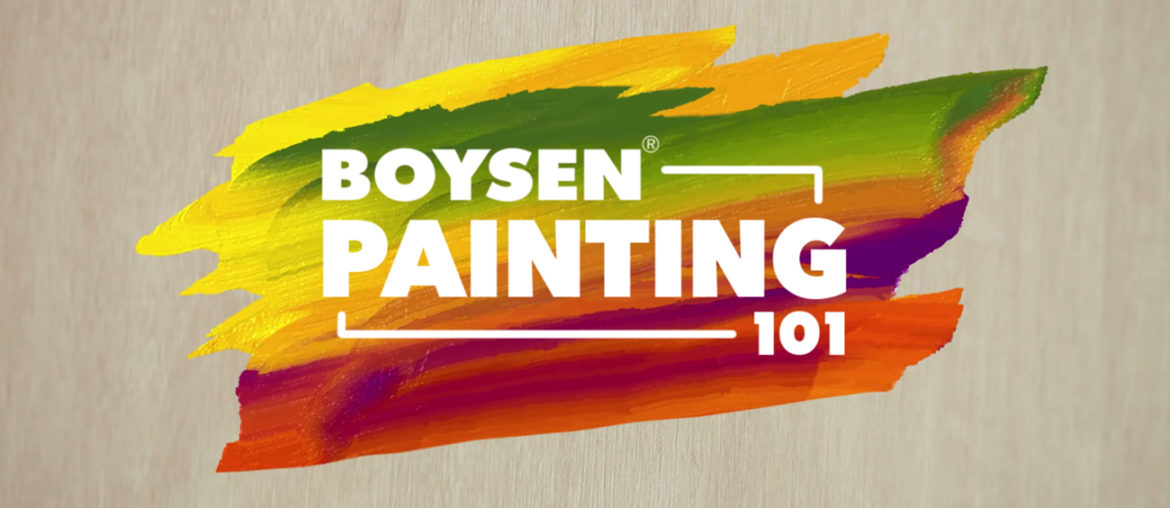Boysen Painting 101 is the title of our video made a few years back that gives a step-by-step tutorial on using Boysen architectural paint for your interiors and exteriors. In other words, if you are a DIYer, then this video will teach you the basics of using Boysen paint. Watch this first before starting your DIY project.
However, it’s not only DIYers that can benefit from watching this Painting 101 video, new professional painters can use this to quickly understand the Boysen paint systems. Even the old-timers can use this as a refresher.
Judging from the more than 350,000 views, this video is the most-watched in our Boysen YouTube channel.
This post is to help you navigate this blog using the Boysen Painting 101 video as a framework.
Get Acquainted with the Tools and Equipment
The tools and equipment you would need depends on the surface you will be painting:
- whether it’s an interior surface or an exterior one
- the kind of surface you will be painting (concrete, wood, metal, or drywall)
- the Boysen paint system you will be using
There are the consumables, like masking tapes, empty cans, paint trays, sandpaper, rags, paint brushes and rollers. The video shows brush sizes that are needed for the different surfaces you will find in your living space.
Important: Use a natural hair brush for solvent-based paint, and an ordinary brush for water-based paint or oil-based enamel.
There are non-consumables like trowels, putty knives, spatulas, spray guns, and mortar guns. For hard-to-reach surfaces like the upper parts of a wall or the ceiling, you can use equipment like gondolas and ladders.
The Boysen Painting 101 gives visuals of the different tools and equipment.
Surface Preparation
The first step is to identify the surface you are going to be painting. There are four types:
- concrete
- wood
- metal
- drywall
We’ve got a whole category in this blog that talks about surface preparation, which arguably is the most important step to do to ensure a smooth, professional, and beautiful finish.
Important: Just remember that painting a surface that has never been painted before requires a different procedure compared to a surface that is going to be repainted.
To make it easier for you, I will put here the links for each surface so that you don’t have to go through the category on surface preparation.
Concrete Surfaces
Surface Preparation for a New Concrete Surface
Surface Preparation for Repainting a Concrete Surface
Wood Surfaces
Surface Preparation for a New Wooden Surface
Surface Preparation for Repainting a Wooden Surface
Metal Surfaces
Surface Preparation for a New Metal Surface
Surface Preparation for Repainting a Metal Surface
Drywall Surfaces
Drywall is a construction material that is used to build ceilings, room dividers, and walls.
Builders prefer using drywall panels for its many benefits, including being resistant to fire, moisture damage, and termites. You could spot drywall panels in a lot of modern Filipino homes, offices, and other buildings today.
Important: Drywall is NOT plywood.
Drywall manufacturers often recommend a paint type and installation process for a specific type of board depending on whether it’s for interior or exterior use. Pros can help you set up drywall panels properly. They can also effectively hide joints and prevent cracks on the surface. These are the things that you have to consider in the preparation process before proceeding with the actual painting.
To know more about what to do with drywall, click on this link.
Common Painting Problems
Common painting problems are also being talked about in the Boysen Painting 101 video. Here are the posts that explain what they are:
Efflorescence | Umido
Mildew | Amag o Lumot
Blistering | Paglobo
Peeling | Pagtuklap
Cracking | Krak
Flaking | Pagbibitak
Chalking | Pamumulbos
Fading | Pangungupas
Lap Marks | Kabisada
Corrosion | Pangangalawang
Saponification | Pagkatas
The Boysen Way
The painting procedure does not change. Think PRIPUPA — use PRImer first, then PUtty, then PAint.
We started with the Boysen Painting 101 video, and went further into detail in the technical articles in this blog.
This year, we will be write articles on the different surfaces and the Boysen paint systems that can be used for each surface. This series is called The Boysen Way. We’ve got one post right now (we just started) and that’s for concrete.
The Boysen Way series is similar to this post. It is a compilation to make it easier for you to know how to handle each surface because the articles in this blog will be listed down for you in one post so you don’t have to do a search.
We would like to make the painting process as painless as possible for you, so subscribe to this blog if you want to see the posts belonging to The Boysen Way series in the next months.
If you can’t wait or you don’t want to do a DIY search, just send an email to ask@myboysen.com or call (02) 8363-9738 local 417 to 418 during office hours and talk to our Technical Team, who will clear up things for you in a jiffy.




